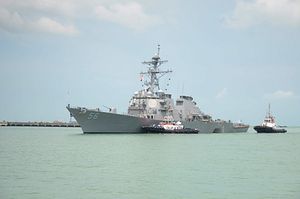The U.S. Navy has dismissed the commander of its 7th Fleet, Vice Admiral Joseph Aucoin, on August 23 due to “loss of confidence in his ability to command,” the service said in a terse statement, following the collision of the Japan-based U.S. destroyer USS John S. McCain with an oil and chemical tanker that left ten sailors missing and injured five.
“Adm. Scott Swift, commander of U.S. Pacific Fleet, today relieved the commander of Seventh Fleet, Vice Adm. Joseph Aucoin, due to a loss of confidence in his ability to command,” the August 23 statement reads. “Rear Adm. Phil Sawyer, who has already been nominated and confirmed for the position and promotion to vice admiral, will assume command immediately.”
Aucoin has been in command of the 7th Fleet since September 2015. The fleets area of operations spans stretches from the International Date Line to the India/Pakistan border; and from the Kuril Islands in the North to the Antarctic in the South. It is the largest of the U.S. Navy’s forward deployed fleets and consists of 50-70 ships and submarines and around 20,000 sailors.
His replacement, Rear Admiral Sawyer, is a career submariner and has been the deputy commander of Pacific Fleet, the theater-level component command in region. Prior to that assignment, Sawyer commanded the U.S. Navy’s submarine forces in the Pacific.
The USS John S. McCain incident is the second deadly ship collision in less than three month. In June, the Japan-based destroyer USS Fitzgerald collided with the merchant vessel ACX Crystal. The accident left seven sailors dead. As a result of an investigation, the ship’s captain, its executive officer, and senior enlisted leader were relieved of their positions. According to the Seventh Fleet spokesperson:
The collision was avoidable and both ships demonstrated poor seamanship. Within Fitzgerald, flawed watch stander teamwork and inadequate leadership contributed to the collision that claimed the lives of seven Fitzgerald Sailors, injured three more, and damaged both ships.
Yet, as Steven Stashwick reported for The Diplomat earlier this week: “Unlike the Fitzgerald collision, whose damage suggests that the U.S. ship was responsible for keeping out of the ACX Crystal’s way, the McCain’s damage on the port (left) side suggests that it was the Alnic MC’s obligation to keep out of the McCain’s way under the international ‘rules of the road’ for preventing collisions.”
As a result of the two recent incidents (in addition to two others that did not cause any fatalities) Chief of Naval Operations Admiral John Richardson has ordered a worldwide “operational pause” across the service and an investigation into U.S. Navy operations in the Western Pacific. Richardson said the series of accidents in the Pacific “demands more-forceful action,” adding that there is “great cause for concern that there is something we are not getting at.”
Richardson also ordered an investigation into how the U.S. Navy prepares its ships and crews for operations in the Pacific: “This will include, but not be limited to, looking at operational tempo, trends in personnel, materiel, maintenance and equipment. It also will include a review of how we train and certify our surface warfare community, including tactical and navigational proficiency.”

































